Data entry is faster and more accurate when you use drop-down lists to limit what people can type in cells. When someone selects a cell, the down arrow of the dropdown appears and can be clicked and selected.
Create a drop-down list / Create a drop-down list
You can make worksheets more efficient by providing drop-down lists. Someone using your sheet clicks an arrow, and then clicks an entry in the list.
1, Select the cell you want to contain the list.
2, In the ribbon, click DATA > Data Validation.
3, In the dialog box, set the Allow option to List.
4, Click "Source", enter the text or numbers you want to use in the drop-down list (separated by commas to form a comma-delimited list, that is, a comma-delimited sequence), and click "OK".
The pop-up window is as follows:

Settings
-
Any value: The cell input content is not limited
-
Whole number: You can enter an integer value
-
Decimal: You can enter values with decimals
-
List: A list of inputable content
-
Date: date
-
Time: time
-
Text length: Specify the string length of the input content
-
Custom: Specifies rules in addition to these built-in validation data validation rules for numeric, date, and text data.
-
Ignore blank: If checked, the cell content will not be affected by data validity rules if it is empty
-
In-cell dropdown: When List is used in the Allow option, this check box is displayed. If it is not checked, the drop-down list will not be displayed.
-
Clear All: After clicking, the data validity settings in all selected cells will be cleared.
When selecting List, you can select a range of cell values as a collection of optional values. Note, however, that only one row or one column can be selected.
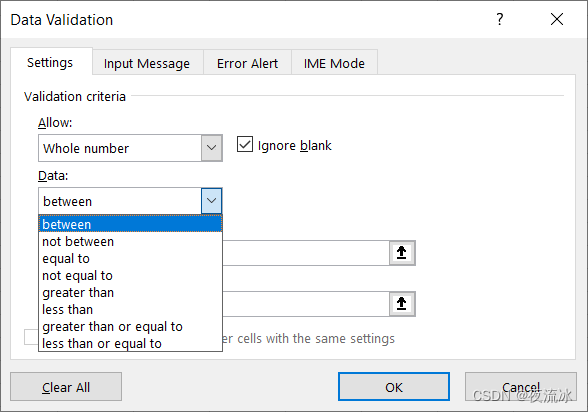
The optional conditions are, between the maximum and minimum values, not between the maximum and minimum values, equal to, not equal to, greater than, less than, greater than or equal to, less than or equal to.
When selecting the maximum and minimum values, you can directly enter the value, or you can refer to the value of a certain cell.
If Allow selects List or Custom, then only the between option can be fixed in the Data option box.
Input Message (input prompt message)
This is used to set the information displayed when the cell is selected to prompt the user about this cell.
You need to set Title and Message, pay attention to check the above check box.
For example, if the data validity setting rule of a cell is a certain range of integers, it is as follows:
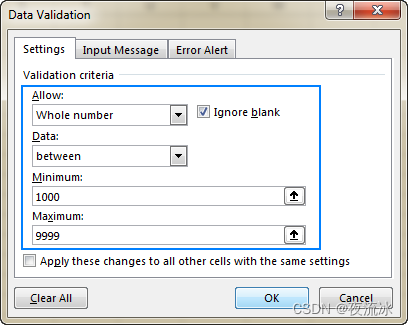

Error Alert
The default is to check the display error warning, and the Style is Stop, which means that if the data input is incorrect, it is required to re-enter. If it is not checked, similar data validity rules will not work.
When invalid content is entered, an error warning, error alert, is displayed.
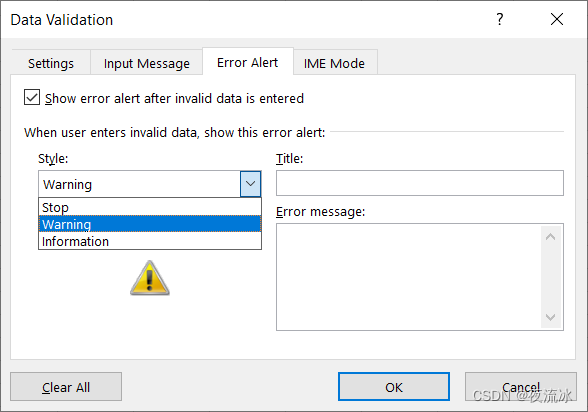
If you select Stop, the input is incorrect and the prompt is as follows. Click Retry to re-enter, and click Cancel to cancel the operation and restore the previous value. This is the strictest warning type, invalid data cannot be entered.
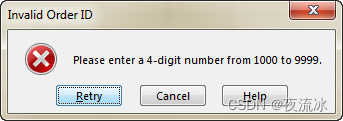
Select Warning, as shown below, click Yes to use the current input value, click No to re-enter, click Cancel to cancel the operation and restore the previous value. Warn the user that this data is invalid, but can still enter it.

Select Information, as shown below, click OK to use the current input value, click Cancel to cancel the operation and restore the previous value. The most permissive type of warning, just to inform the user that the data is invalid.
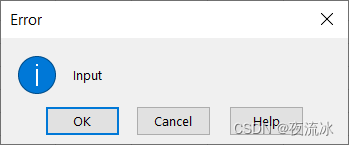
If you do not set the content of the error warning message, the default title is "Microsoft Excel" and the message is "This value does not match the data validation restrictions defined for this cell.".
IMAGE Mode
If Off is selected, Chinese, Japanese and Korean characters cannot be input.
An Input Method Editor (IME) is a software component that enables a user to enter text in a language that cannot be easily represented on a standard QWERTY keyboard. Use of this editor is usually done taking into account the number of characters in the user's written language, such as various East Asian languages.
The user types key combinations that are interpreted by the IME, rather than the individual characters displayed on each individual keyboard key. The IME generates a list of characters that match the keystroke set or candidate characters from which the user can choose. The selected characters are then inserted into the edit control with which the user interacts.
Replication of Data Validation
Select a cell with data validity settings, then Ctrl + C, then select the cell to be copied, right click, click Paste Special, find Validation and paste it.
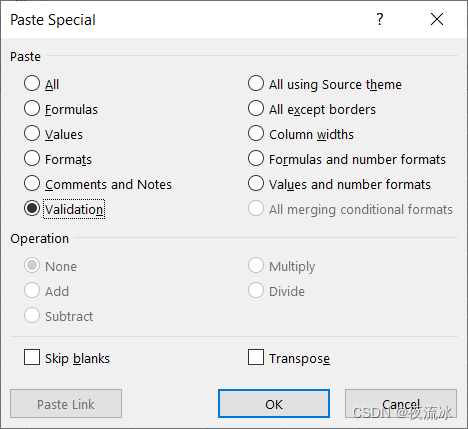
With this method, you can also clear the Validation of selected cells by copying the Data Validation of empty cells.
In the Setting of Data Validation, there is a check box "Apply these changes to all other cells with the same settings." If it is checked, when the current condition is modified, the same as the current Validation condition will also be accepted Revise.
Note Notes
Excel's data validation rules, whether built-in or customized, will only verify the data in the newly entered cells after the rules are set, and the existing data will not be affected by the validation rules.
If you often use Excel, using shortcut keys can simplify the operation. For example, after pressing the Alt key, the shortcut keys of each menu will be displayed, and then press the key to switch the corresponding tab group, and continue to operate by referring to the shortcut keys of the displayed menu.
reference:
1,Excel 2013 training
Excel 2013 training - Microsoft Support
2. Input Method Editor (IME)
Input Method Editors (IME) - Windows apps | Microsoft Learn
3, Ignore blank option
Excel Data Validation - Ignore Blank
4,Excel Data Validation
Data validation in Excel: how to add, use and remove
5,Excel Data Validation Custom Rules